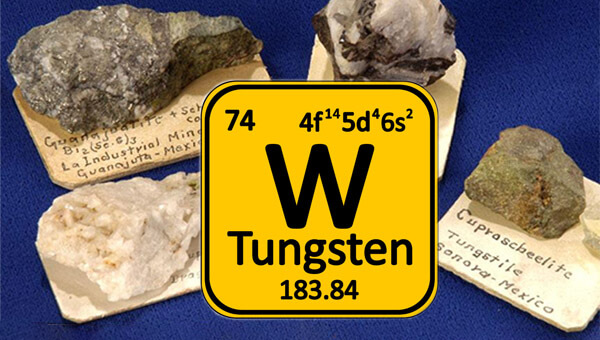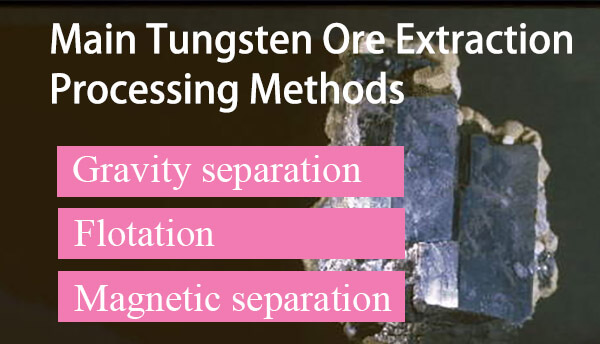Extraction of tungsten
Tungsten ore processing, that is separation and beneficiation of tungsten minerals from tungsten bearing ores. Tungsten concentrates are sent to smelters to refine the metals tungsten, tungsten carbide, tungsten alloys and tungsten compounds, while tungsten middlings is chemically treated to produce synthetic scheelite, ammonium paratungstate, tungsten powder and tungsten carbide.

Minerals and Resources
There are more than 30 kinds of tungsten minerals in nature, but tungsten minerals of industrial significance are mainly scheelite and wolframite, followed by Calcium tungsten molybdenum ore (CaMo)wo, and copper-tungsten (Cuwo).
Wolframite can be divided into Ferberite, wolframite and huebnerite according to the content of FeO and MnO. Wolframite has weak magnetism, which increases with the increase of iron content.
Tungsten distribution
The world’s tungsten resources are mainly concentrated in the countries bordering Asia and the Pacific. China’s tungsten reserves and production ranks the World First, mainly in wolframite. Other major tungsten producing countries are the former Soviet Union, Canada, South Korea, Bolivia and so on, dominated by scheelite.
Tungsten mineral Processing flow
How is tungsten extracted from its ore? The main beneficiation methods for tungsten ores are physical methods such as pre-concentration, gravity concentration, flotation and magnetic separation; as for the refractory middling ore and low-grade concentrate, prefer to chemical concentration way.
1 Beneficiation processing of wolframite
Wolframite property: tungsten from wolframite ore mostly in quartz vein type, high dilution rate, low grade, coarse particle size, high density, low hardness, easy sliming and deep color. Wolframite mineral processing method mainly in gravity separation, and includes four parts: pre-selection, gravity separation, concentration and recovery.
- Pre-selection ore washing, desliming and classification should be carried out before the pre-selection, the pre-selection methods have hand picking, photoelectricity picking, and heavy medium separation, etc.
By pre-selection and discarding the waste rock which accounts for 50% of the raw ore, the WO3 grade of the ore is enriched from 0.25% ~ 0.3% to 0.45% ~ 0.8 %, and the recovery is 96% ~ 98 %. - Gravity separation adopts a combination of jig machine and shaking table to recover coarse tungsten ore.
According to different gravity separation working principle, gravity separator can be subdivided into a shaking table, mineral jig, spiral chute and centrifugal separator.
Shaking table is one of the most widely used gravity equipment for separating fine materials. Compared with the cone concentrator, spiral concentrator and other fine particle separation equipment, the processing capacity of the shaking table is lower. But it has such outstanding advantages as a high enrichment ratio, the final concentrate can be obtained after one separation and wide application range.
Jigging machine is the main beneficiation method for wolframite, it has the great characteristics of large particle size, high treatment capacity, high separation efficiency and low water consumption. It is excellent equipment for gravity separation of coarse and medium-sized ores and has been widely used in wolframite mines.
The Centrifugal force produced by the high-speed rotation of the concentrator strengthens the gravity separation process and makes the recovery of the fine particles more effective.
Gravity separator types and specification - Magnetic separation Wolframite has weak magnetic properties, the high-intensity magnetic separation equipment ( such as SLon vertical high gradient strong magnetic separator ) do a great help for wolframite recovery. Which magnetic separator suited for your mine?
- Flotation The flotation process is usually used to treat extra fine wolframite slime.
Fine flotation requires high selectivity of collectors, such as arsonic acid, phosphonic acid, chelate, amphoteric collectors and a few fatty acid collectors. Among them, arsonic acid and phosphonic acid collectors have certain toxicity, are easy to bring about environmental pollution problems, and have high manufacturing costs. Therefore, these kinds of collectors are hardly used in the current flotation process In recent years, the use of hydroxamic acid collectors is a good solution to this problem.
2 Scheelite mineral processing flow
According to the paragenetic relationship between scheelite and different types of gangue ores, scheelite ores can be divided into different types, and the beneficiation methods for different types of scheelite ores are also different. For example, scheelite-quartz (or silicate) type can be used in combination with gravity separation and flotation according to the particle size distribution, while scheelite-calcite-fluorite-barite type can be recovered by flotation.
The separation methods of scheelite are different with different disseminated grain size. For coarse-grained scheelite, generally uses a gravity separation method, which has the advantages of lower cost, less environmental pollution and higher recovery ratio. For fine size scheelite, the separation uses the flotation separation method.
Scheelite is often associated with a variety of sulfide ore, common molybdenite, chalcopyrite and pyrite, etc. during the beneficiation process, the sulfide ore should be floated out first.
Scheelite flotation is carried out in alkaline medium, adjust slurry PH value in 9 ~ 10 by the sodium carbonate, sodium hydroxide. Common inhibitors are sodium silicate, tannin, various phosphates. Collectors have sodium oleate, tar oil and oxidized paraffin, etc.
Scheelite has good floatability, but it is often associated with fluorite, calcite, apatite, barite and gangue minerals containing calcium and barium, those have similar floatability, increase the separation difficulty. In order to improve the flotation selectivity of scheelite and calcareous gangue minerals, multi-metal salts, such as iron sulfate, are often used in combination with sodium silicate to improve the flotation effect of scheelite.
Mixed wolframite and scheelite beneficiation processing
For the single scheelite and wolframite with simple composition, the separation process is relatively simple. For the paragenetic ore of wolframite and scheelite, especially the paragenetic polymetallic ore of fine-grained wolframite and scheelite, tungsten is usually recovered by a mixed flotation process. There is two main tungsten ore dressing plant design:
(1) Mixed flotation of sulfide ore – mixed flotation of wolframite-heated scheelite concentrate – strong magnetic separation of Scheelite tailings – gravity separation of Wolframite;
(2) Mixed flotation of sulfide ores – strong magnetic separation of wolframite – scheelite flotation-wolframite flotation.
Case – Tungsten ore processing plant
JXSC focuses on mining equipment manufacturing, established in 1985,has quite of experience of mining machine configuration and layout design & optimization among various minerals, gold, silver, diamond, copper, titanium, tungsten, coltan, chrome, and so on.

